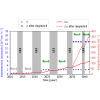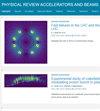Energy deposition studies for the Upgrade II of LHCb at the CERN Large Hadron Collider
IF 1.8
3区 物理与天体物理
Q3 PHYSICS, NUCLEAR
Physical Review Accelerators and Beams
Pub Date : 2024-06-24
DOI:10.1103/physrevaccelbeams.27.061003
引用次数: 0
Abstract
The Upgrade II of the Large Hadron Collider beauty (LHCb) experiment is proposed to be installed during the CERN Long Shutdown 4, aiming to operate LHCb at that is 75 times its design luminosity [1] and reaching an integrated luminosity of about by the end of the High Luminosity LHC era. This increase of the data sample at LHCb is an unprecedented opportunity for heavy flavor physics measurements. A first upgrade of LHCb (Upgrade I), completed in 2022, has already implemented important changes of the LHCb detector and, for the Upgrade II, further detector improvements of the tracking system, the particle identification system and the online and trigger infrastructure are being considered. Such a luminosity increase will have an impact not only on the LHCb detector but also on the LHC magnets, cryogenics, and electronic equipment placed in the insertion region 8. In fact, the LHCb experiment was conceived to work at a much lower luminosity than ATLAS and CMS, implying minor requirements for protection of the LHC elements from the collision debris, and therefore, a different layout around the interaction point. The Upgrade I has already implied the installation of an absorber for the neutral particle debris (TANB). However, the luminosity target proposed for this second upgrade requires to review the layout of the entire insertion region in order to ensure safe operation of the LHC magnets and to mitigate the risk of failure of the electronic devices. The objective of this paper is to provide an overview of the implications of the Upgrade II of LHCb in the experimental cavern and in the tunnel with a focus on the LHCb detector, electronic devices, and accelerator magnets. This proves that the Upgrade II luminosity goal can be sustained with the implementation of protection systems for magnets and electronics. The electronics placed in the experimental areas and in the cavern needs to be protected to mitigate a single event effect risk, which may imply recurring downtime of the LHC. On the other hand, protection for the first quadrupole of the final focus triplet and for the separation dipole are needed to prevent their quench and to reach the desired lifetime. Moreover, the normal-conducting compensators require the installation of shielding to limit their head coil degradation.

欧洲核子研究中心大型强子对撞机 LHCb 升级 II 的能量沉积研究
大型强子对撞机美学(LHCb)实验的升级 II 拟在欧洲核子研究中心长期关闭 4 期间安装,目的是使 LHCb 以 1.5×1034 cm-2 s-1 的速度运行,是其设计光度的 75 倍[1],并在高光度 LHC 时代结束时达到约 400 fb-1 的综合光度。LHCb 数据样本的增加为重味道物理测量提供了前所未有的机会。2022年完成的大型强子对撞机b的第一次升级(升级I)已经对大型强子对撞机b探测器进行了重要改动,而对于升级II,正在考虑进一步改进探测器的跟踪系统、粒子识别系统以及在线和触发基础设施。光度的增加不仅会对大型强子对撞机探测器产生影响,还会对放置在插入区8的大型强子对撞机磁铁、低温设备和电子设备产生影响。事实上,LHCb 实验的设想是在比 ATLAS 和 CMS 低得多的光度下工作,这意味着对保护 LHC 元件免受碰撞碎片影响的要求较低,因此在相互作用点周围的布局也有所不同。升级 I 已经意味着要安装中性粒子碎片吸收器(TANB)。然而,第二次升级提出的光度目标要求重新审视整个插入区域的布局,以确保大型强子对撞机磁体的安全运行,并降低电子设备的故障风险。本文旨在概述大型强子对撞机b第二次升级对实验洞室和隧道的影响,重点是大型强子对撞机b探测器、电子设备和加速器磁铁。这证明,在对磁体和电子设备实施保护系统后,升级版 II 的光度目标是可以维持的。放置在实验区和洞穴中的电子设备需要得到保护,以降低单一事件影响的风险,这可能意味着大型强子对撞机的经常性停机。另一方面,需要对最终聚焦三重的第一个四极子和分离偶极子进行保护,以防止其淬火并达到所需的寿命。此外,正常传导补偿器需要安装屏蔽装置,以限制其头部线圈的退化。
本文章由计算机程序翻译,如有差异,请以英文原文为准。
求助全文
约1分钟内获得全文
求助全文
来源期刊

Physical Review Accelerators and Beams
Physics and Astronomy-Surfaces and Interfaces
CiteScore
3.90
自引率
23.50%
发文量
158
审稿时长
23 weeks
期刊介绍:
Physical Review Special Topics - Accelerators and Beams (PRST-AB) is a peer-reviewed, purely electronic journal, distributed without charge to readers and funded by sponsors from national and international laboratories and other partners. The articles are published by the American Physical Society under the terms of the Creative Commons Attribution 3.0 License.
It covers the full range of accelerator science and technology; subsystem and component technologies; beam dynamics; accelerator applications; and design, operation, and improvement of accelerators used in science and industry. This includes accelerators for high-energy and nuclear physics, synchrotron-radiation production, spallation neutron sources, medical therapy, and intense-beam applications.
 求助内容:
求助内容: 应助结果提醒方式:
应助结果提醒方式:


